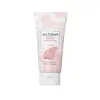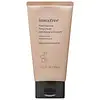What's inside
What's inside
 Key Ingredients
Key Ingredients

 Benefits
Benefits

 Concerns
Concerns

 Ingredients Side-by-side
Ingredients Side-by-side

Water
Skin ConditioningGlycerin
HumectantCalamine
AbsorbentZinc Oxide
Cosmetic ColorantKaolin 6%
AbrasiveBentonite 4%
AbsorbentDipropylene Glycol
HumectantGlyceryl Stearate
EmollientPalmitic Acid
EmollientStearic Acid
Cleansing1,2-Hexanediol
Skin ConditioningAmyris Balsamifera Bark Oil
MaskingLavandula Angustifolia Oil
MaskingPelargonium Graveolens Flower Oil
MaskingEucalyptus Globulus Leaf Oil
PerfumingLitsea Cubeba Fruit Oil
MaskingMentha Arvensis Leaf Oil
MaskingMelaleuca Alternifolia Leaf Oil
AntioxidantJuniperus Mexicana Oil
MaskingCitrus Aurantium Bergamia Fruit Oil
MaskingVolcanic Ash
AbrasiveBoswellia Carterii Oil
MaskingMyristica Fragrans Kernel Oil
MaskingCitrus Aurantium Dulcis Peel Oil
MaskingHamamelis Virginiana Water
AstringentCamellia Japonica Flower Extract
EmollientTagetes Minuta Flower Oil
MaskingCitrus Paradisi Peel Oil
MaskingEpilobium Fleischeri Extract
Skin ConditioningMoringa Oleifera Seed Extract
Skin ConditioningRosa Multiflora Fruit Extract
MaskingPortulaca Oleracea Extract
Skin ConditioningGossypium Herbaceum Seed Extract
Skin ConditioningCaprylic/Capric Triglyceride
MaskingTromethamine
BufferingCaprylyl Glycol
EmollientCellulose Gum
Emulsion StabilisingPanthenol
Skin ConditioningEthylhexylglycerin
Skin ConditioningSodium Phytate
Myristic Acid
CleansingAllantoin
Skin ConditioningArachidic Acid
CleansingLauric Acid
CleansingOleic Acid
EmollientButylene Glycol
HumectantZinc PCA
HumectantMaltodextrin
AbsorbentTocopherol
AntioxidantCitric Acid
BufferingXanthan Gum
EmulsifyingPotassium Sorbate
PreservativeLimonene
PerfumingParfum
MaskingCI 77492
Cosmetic ColorantCI 77491
Cosmetic ColorantWater, Glycerin, Calamine, Zinc Oxide, Kaolin 6%, Bentonite 4%, Dipropylene Glycol, Glyceryl Stearate, Palmitic Acid, Stearic Acid, 1,2-Hexanediol, Amyris Balsamifera Bark Oil, Lavandula Angustifolia Oil, Pelargonium Graveolens Flower Oil, Eucalyptus Globulus Leaf Oil, Litsea Cubeba Fruit Oil, Mentha Arvensis Leaf Oil, Melaleuca Alternifolia Leaf Oil, Juniperus Mexicana Oil, Citrus Aurantium Bergamia Fruit Oil, Volcanic Ash, Boswellia Carterii Oil, Myristica Fragrans Kernel Oil, Citrus Aurantium Dulcis Peel Oil, Hamamelis Virginiana Water, Camellia Japonica Flower Extract, Tagetes Minuta Flower Oil, Citrus Paradisi Peel Oil, Epilobium Fleischeri Extract, Moringa Oleifera Seed Extract, Rosa Multiflora Fruit Extract, Portulaca Oleracea Extract, Gossypium Herbaceum Seed Extract, Caprylic/Capric Triglyceride, Tromethamine, Caprylyl Glycol, Cellulose Gum, Panthenol, Ethylhexylglycerin, Sodium Phytate, Myristic Acid, Allantoin, Arachidic Acid, Lauric Acid, Oleic Acid, Butylene Glycol, Zinc PCA, Maltodextrin, Tocopherol, Citric Acid, Xanthan Gum, Potassium Sorbate, Limonene, Parfum, CI 77492, CI 77491
Water
Skin ConditioningGlycerin
HumectantMyristic Acid
CleansingStearic Acid
CleansingPEG-32
HumectantPotassium Hydroxide
BufferingButylene Glycol
HumectantPalmitic Acid
EmollientLauric Acid
CleansingHydrated Silica
AbrasiveLauryl Glucoside
CleansingGlyceryl Stearate
EmollientPEG-100 Stearate
Cocamidopropyl Betaine
CleansingParfum
MaskingZea Mays Starch
AbsorbentPolyquaternium-7
Sodium Chloride
MaskingMannitol
HumectantMicrocrystalline Cellulose
AbsorbentDisodium EDTA
Sodium Benzoate
MaskingVolcanic Ash
AbrasiveSilica
AbrasiveLactic Acid
BufferingWater, Glycerin, Myristic Acid, Stearic Acid, PEG-32, Potassium Hydroxide, Butylene Glycol, Palmitic Acid, Lauric Acid, Hydrated Silica, Lauryl Glucoside, Glyceryl Stearate, PEG-100 Stearate, Cocamidopropyl Betaine, Parfum, Zea Mays Starch, Polyquaternium-7, Sodium Chloride, Mannitol, Microcrystalline Cellulose, Disodium EDTA, Sodium Benzoate, Volcanic Ash, Silica, Lactic Acid
 Reviews
Reviews

Ingredients Explained
These ingredients are found in both products.
Ingredients higher up in an ingredient list are typically present in a larger amount.
Butylene Glycol (or BG) is used within cosmetic products for a few different reasons:
Overall, Butylene Glycol is a safe and well-rounded ingredient that works well with other ingredients.
Though this ingredient works well with most skin types, some people with sensitive skin may experience a reaction such as allergic rashes, closed comedones, or itchiness.
Learn more about Butylene GlycolGlycerin is already naturally found in your skin. It helps moisturize and protect your skin.
A study from 2016 found glycerin to be more effective as a humectant than AHAs and hyaluronic acid.
As a humectant, it helps the skin stay hydrated by pulling moisture to your skin. The low molecular weight of glycerin allows it to pull moisture into the deeper layers of your skin.
Hydrated skin improves your skin barrier; Your skin barrier helps protect against irritants and bacteria.
Glycerin has also been found to have antimicrobial and antiviral properties. Due to these properties, glycerin is often used in wound and burn treatments.
In cosmetics, glycerin is usually derived from plants such as soybean or palm. However, it can also be sourced from animals, such as tallow or animal fat.
This ingredient is organic, colorless, odorless, and non-toxic.
Glycerin is the name for this ingredient in American English. British English uses Glycerol/Glycerine.
Learn more about GlycerinGlyceryl Stearate is a mix of glycerin and stearic acid.
It is used to stabilize the mixing of water and oil ingredients. By preventing these ingredients from separating, it can help elongate shelf life. It can also help thicken the product's texture.
As an emollient, it helps soften skin and supports barrier-replenishing ingredients.
In cosmetics, Glyceryl Stearate is often made from vegetable oils or synthetically produced.
This ingredient may not be fungal-acne safe
Fun fact: The human body also creates Glyceryl Stearate naturally.
Learn more about Glyceryl StearateLauric Acid is a fatty acid or lipid. About half of fatty acids in coconut oil is lauric acid.
This ingredient helps hydrate and sooth skin. As a humectant, it helps trap moisture. It also aids in cleaning and enhancing the texture of products.
Lauric acid may not be Malassezia folliculitis, or fungal acne, safe.
Learn more about Lauric AcidMyristic Acid is a saturated fatty acid. It is naturally found in milk fat. Other sources include palm oil, coconut oil, and butter fat.
Myristic Acid is an emulsifer and cleanser. As an emulsifer, it stabilizes a product by preventing ingredients from separating. Myristic Acid helps clean your skin by acting as a surfactant. It tends to gather oil and dirt on your skin to be easily rinsed away.
One study from 2021 found Myristic Acid to have anti-inflammatory properties.
Learn more about Myristic AcidPalmitic Acid is a fatty acid naturally found in our skin and in many plant and animal sources. In cosmetics, it is usually derived from palm oil. It serves many purposes in skincare, acting as a cleanser, emollient, and emulsifier.
As an emollient, palmitic acid helps soften and smooth the skin by preventing water loss. In cleansers, it helps remove oil and dirt while creating foam.
Its emulsifying properties help stabilize products by keeping water and oil-based ingredients from separating.
This may not be suitable for fungal acne-prone skin, as fatty acids like this can sometimes trigger breakouts in sensitive individuals.
Learn more about Palmitic AcidParfum is a catch-all term for an ingredient or more that is used to give a scent to products.
Also called "fragrance", this ingredient can be a blend of hundreds of chemicals or plant oils. This means every product with "fragrance" or "parfum" in the ingredients list is a different mixture.
For instance, Habanolide is a proprietary trade name for a specific aroma chemical. When used as a fragrance ingredient in cosmetics, most aroma chemicals fall under the broad labeling category of “FRAGRANCE” or “PARFUM” according to EU and US regulations.
The term 'parfum' or 'fragrance' is not regulated in many countries. In many cases, it is up to the brand to define this term.
For instance, many brands choose to label themselves as "fragrance-free" because they are not using synthetic fragrances. However, their products may still contain ingredients such as essential oils that are considered a fragrance by INCI standards.
One example is Calendula flower extract. Calendula is an essential oil that still imparts a scent or 'fragrance'.
Depending on the blend, the ingredients in the mixture can cause allergies and sensitivities on the skin. Some ingredients that are known EU allergens include linalool and citronellol.
Parfum can also be used to mask or cover an unpleasant scent.
The bottom line is: not all fragrances/parfum/ingredients are created equally. If you are worried about fragrances, we recommend taking a closer look at an ingredient. And of course, we always recommend speaking with a professional.
Learn more about ParfumStearic Acid is a fatty acid. It is an emollient, emulsifier, and texture enhancer.
As an emollient, stearic acid helps soften skin. It aids the skin's protective barrier by preventing water loss. It also provides a gentle cleansing effect without stripping away natural oils.
Stearic acid may also be used to enhance the texture of products. It can add volume and stabilize ingredients such as water and oil. This can help water and oil ingredients from separating.
Sources of stearic acid include animal or vegetable fats/oils such as coconut or shea. It can be naturally found in butter, cocoa butter, shea butter, vegetable fats, and animal tallow.
This ingredient may not be Malassezia folliculitis, or fungal-acne safe.
Learn more about Stearic AcidVolcanic Ash is an exfoliant.
Water. It's the most common cosmetic ingredient of all. You'll usually see it at the top of ingredient lists, meaning that it makes up the largest part of the product.
So why is it so popular? Water most often acts as a solvent - this means that it helps dissolve other ingredients into the formulation.
You'll also recognize water as that liquid we all need to stay alive. If you see this, drink a glass of water. Stay hydrated!
Learn more about Water